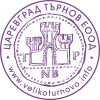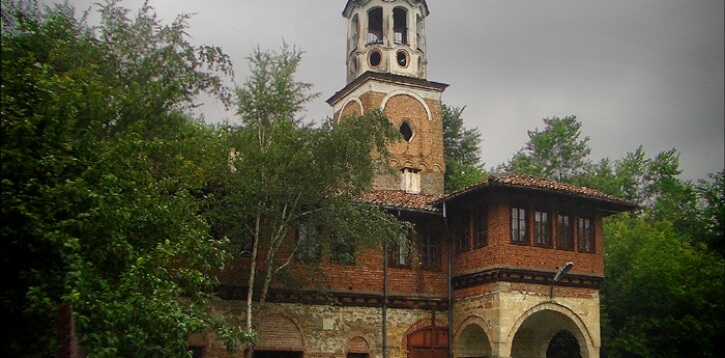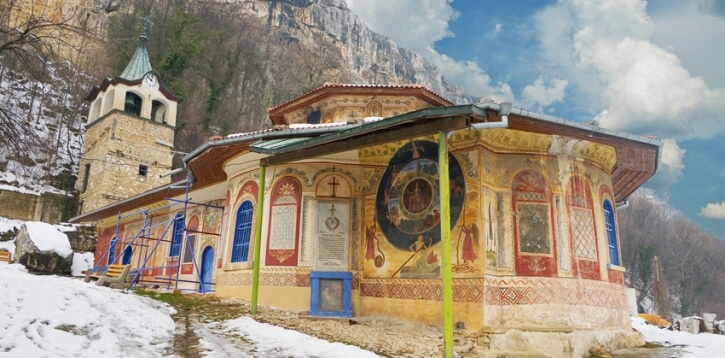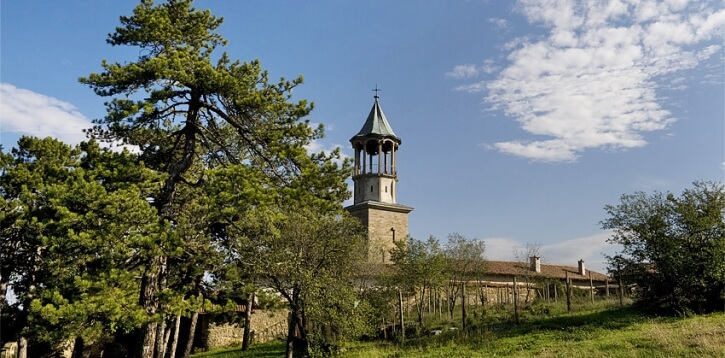The emergence of the Kilifarevo Monastery is closely connected with the name of Theodossius of Turnovo, an acknowledged Bulgarian Hesychast and man of letters. He settled in these parts towards 1348, a few years after the death of the famous Hesychast Gregory Sinait, whose monastery in Southern Strandzha he had inhabited before.
Accompanied by his disciple Romil of Vidin, after several years of roaming about Mount Athos and Eastern Bulgaria, St Theodossius finally found seclusion in the thick forests above the River Belitsa near the village of Kilifarevo. Gradually, more followers gathered round him and soon afterwards a monastery was raised at this place with the assistance of Tsar Ivan Alexander, which in no time turned into a significant literary center of 14th century Bulgaria, into a spiritual haven of Orthodox Hesychasm. All kinds of liturgical books, lives, homilies and secular chronicles were written and translated here. It was exactly at the Kilifarevo Cloister that the creative endeavours of Patriarch Euthymius and Romil of Vidin were first given an impulse, of the future Metropolitan Bishop of Kiev and Moscow Kyprian and of many other adherents. When the Ottoman invaders reached Turnovo towards the end of the mid – 14th century, the monastery was fortified with walls and fortress towers. Tsar Ivan Alexander personally donated funds for the construction of the chief tower and a new church.
Present-day excavations have helped determine the outline of the fortress and the thick walls (from 2.20 m to 2.95 m) encircling a big courtyard of an irregular shape. The zones were designated upon three terraces sloping in an east-west direction. The main communications backbone, interconnecting the separate zones, ran in the same direction. During the Ottoman invasion this fortified monastic establishment, situated above the River Belitsa, was destroyed despite the local resistance. In 1442 the monastery was mentioned again while in 1596 it gave shelter to the insurgents who had survived after the Second Turnovo Uprising. For that reason the Turks set it on fire once more on the order of Sinan Pasha and its fortified walls were razed to the ground. Never again was such a sacred abode erected on that very site.
Today the Kilifarevo Monastery lies at the foot of the hill very close to the riverside. People believe that it was raised at this place in the 16th century, immediately after the destruction of the old cloister. However, a careful analysis of its present-day cathedral church reveals that the two chapels at the eastern end of the structure are actually the remains of the altar tract of a big medieval three-apse church. The chapels of St Theodossius of Turnovo and of the Reposed St John of Rila with an ossuary underneath are fragments of its prosthesis and the central altar space.
The data thus disclosed throw a new light on the whole span of the Kilifarevo Monastery’s history. Obviously, such an imposing church building could have belonged only to a big monastic establishment and by no means to a small cloister. Testifying to this are the numerous remains of solid walls which have been discovered here during excavation works at different times over the last century. The conclusion can therefore be drawn that side by side there must have existed two independent monasteries – the Kilifarevo fortified cloister and an other one, lying below, by the riverside. In probability, the second foundation emerged later, as a result of the gathering of a large number of monks – followers of the famous Hesychast School. Similarly, a few more monastic communities emerged around the notable Sinait Monastery in the Strandzha Mountains in only about ten years after its foundation.
The present-day cathedral church has preserved material evidence which throws light upon Kilifarevo Monastery’s later history.
Re-erected in 1596 upon the ruins of the lower cloister, it was initially the western parts of the old medieval church that were accommodated to serve the purposes of the Christian liturgy. Later on, in the 19th century, when the present-day church was raised, inserted behind its altar were parts of the former temple’s altar which had in the 17th-18th centuries been transformed into a chapel and an ossuary. The Chapel of St Theodossius of Turnovo was skillfully hidden behind the altar when the Revival Period church was built by grandmaster Nikola Fichev. The surviving-eastern part is remarkable for its intricate architecture covered all with murals from the late 17th – early 18th centuries. The disposition and stylistic features of the decoration betray the spirit of the 17th century art of church painting. Depicted in the conch of the apse are the image of the Holy Virgin – Queen of Heaven, the Communion of the Apostles underneath and the Adoration of the Sacrifice further below. The traditional Annunciation is by the side of the apse. The central part of the vault displays God Savaot, Christ the Almighty and Christ Emanuil in the east-west direction. Further below along the walls is the tier of standing figures of saints and archangels with prophets beneath, inserted into painted arches – a characteristic trend for the Turnovo region. Rearranged within the architecturally shaped sections are the figures of evangelists, friezes of tiny medallions featuring busts of martyrs and small-sized scenes illustrative of the Bible. The lowermost band of paintings incorporates the full-length figures of saints-warriors and Reverends. Supposedly, these images were depicted after the outrages against the monastery in 1686. According to a legend, the paintings were the work of an artist from Turnovo.
The iconostasis of the oldest among the monastery’s cult buildings has three tiers of icons. Its ornately carved structure is a fusion of details from two different periods. Its central part is of an earlier date, and the fretwork of the Apostles’ frieze is closer to the design of the 18th century Arbanassi churches. Added to its extension were details characteristic of the 19th century. The icons in the first band – the Holy Virgin Showing the Way, Christ the Almighty, John the Precursor and St Nicholas – were also painted in the 19th century while those in the festal tier were executed at different times. From 1793 to the close of the century the Kilifarevo Monastery was on several occasions plundered by the Kurdjalis. The residential wing was burnt down but the church survived. The icon-paintings were cut up in pieces, as noted in a letter of Hieromonk Zachariusin 1805. It was only after the year 1800 that new construction works of greater importance were undertaken when that same Hieromonk Zacharius was abbot, succeeded later by Hieromonk Samouil. Initially, the residential wings were restored whereupon a one-storied lath-and-plaster building was raised. Towards 1830-1835, when Hieromonk Theodorit was abbot and the monastery became wealthy, funds began to be raised for the construction of a new cathedral church and other larger buildings. The residential wing demolished in the opening years of this century. A few years later, when a permit was obtained from the Sultan’s Office in 1840, the construction of the big residential wing and the extension of the church began simultaneously. However, with such a sweeping building programme underway, the church was completed only in 1844, and the residential structure above the river – in 1849. Grand-master Nikola Fichev was the chief builder. With the keen artistic sense characteristic of him, he succeeded in merging the new buildings with the surviving old parts thus achieving the impact of a harmonious whole.
He raised the chief monastery temple to adjoin the medieval chapels to the west, skillfully inserting them into the new volume which had a vast three-nave naos and a wide dome rising in the middle. The facade surfaces were decorated with a two-step Lombard arcature and a bold convex-concave cornice resting on a toothed frieze of bricks. Above the western gate the cornice shapes a balance-beam pediment, the field of which is richly adorned with a sculpted Golgotha cross, two archangels, cypresses and stylized floral motifs. The dome is many sided and wide, yet too low to dominate the silhouette of the temple. Developed vertically, the windows are shaped like ellipses.
In structure and style of fretwork execution the iconostasis of the new Church of St Nicholas resembles those at the temples of Preobrazhenie and Plakovo monasteries. Their altar gates are very much alike, especially in form, composition and pattern. The icons of St George, Archangel Gabriel, the Nativity of the Virgin, St Demetrius, the Holy Virgin, Christ the Almighty, John the Baptist, the New Testament Trinity and Archangel Michael were painted by different masters from the Tryavna school. The patronal image of St Demetrius contains an inscription with the name of Dosyu Koev as its author; the icon-painting of the Holy Virgin was signed by Yonko Papavitanov from Tryavna in 1843; St John of Rila with Lives was painted by Krustyu Zahariev while the icon on the northern proscinitarius, depicting the Annunciation, was executed in 1880 by Tsanyu Zahariev. Most of the images were painted by Yonko Papavitanov in 1843.
The monastery’s residential wing rose just over the river bank with a high stone ground floor, above which a frame-built second storey stood out white with .a string of oriels imparting the feeling of movement. It was a two-storeyed building from the direction of the courtyard, with verandas in the middle which had a big open projection. The lower level accommodated the catering block, guest rooms and two-section monastic cells while the upper level housed cells, guest rooms and the abbot’s place. The proportions of the volumes, the quality of masonry and the joinery reveal talented craftsmanship.
During the second half of the 19th century, at the time of Hieromonk Hadji Isaiah as monastery’s abbot when the clergy numbered forty in all, a bridge was built over the River Belitsa to make the access to the monastery easier. The famous master from Kilifarevo Nedyalko Yurdanov (1835-1930) insisted that the depth of its foundations be increased but nobody would listen to him, as a result of which the bridge fell in a great flood. What we see today is a new structure. The handsome main gateway with the adjoining parts of the wall were erected in 1856. The Kilifarevo Monastery School, set up as early as the Middle Ages, continued to function until the middle decades of the century, even if with certain interruptions.








